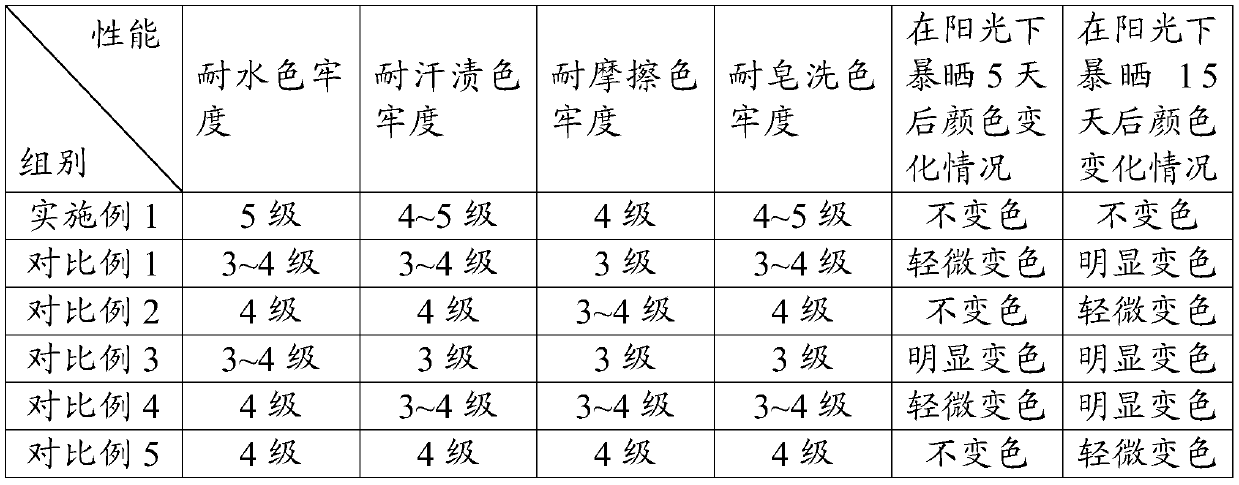Vegetable dye for fabrics and preparation method of vegetable dye
A plant dye and plant dye technology, applied in the field of plant dyes for fabrics and their preparation, can solve the problems of polluting environmental water resources, potential safety hazards, skin allergies, etc., and achieve low volatility, low pollution, and strong washing resistance. Effect
- Summary
- Abstract
- Description
- Claims
- Application Information
AI Technical Summary
Problems solved by technology
Method used
Image
Examples
Embodiment 1
[0028] The present embodiment provides a kind of vegetable dye for fabric, comprises the raw material of following weight portion:
[0029] 20 parts of vegetable dyes, 37.5 parts of dimethyl carbonate, 1.5 parts of urea, 4 parts of polyethylene glycol, 1 part of sodium polyacrylate, 0.85 parts of sodium cellulose sulfonate, 0.35 parts of diphenylamine, 2.4 parts of sodium bicarbonate, 7 parts of ethylenediaminetetraacetic acid, 70 parts of deionized water.
[0030] Wherein the plant coloring agent is grape skin extract.
[0031] The present embodiment also provides the preparation method of above-mentioned vegetable dye for fabric, comprises the following steps:
[0032] Step 1. Wash and dry the grape skins, crush them, pass through a 40-mesh sieve, and then mix them with an ethanol solution with a mass fraction of 75% according to a mass ratio of 1:15. Ultrasound at 45°C for 1.5h, filter and place the filtrate at 40°C. Rotary evaporation at ℃, drying and concentrating to ob...
Embodiment 2
[0037] The present embodiment provides a kind of vegetable dye for fabric, comprises the raw material of following weight portion:
[0038] 18 parts of vegetable dyes, 35 parts of dimethyl carbonate, 1 part of urea, 5 parts of polyethylene glycol, 0.8 parts of sodium polyacrylate, 0.7 parts of sodium cellulose sulfonate, 0.3 parts of diphenylamine, 2.2 parts of sodium bicarbonate, 6 parts of ethylenediaminetetraacetic acid, 60 parts of deionized water.
[0039] Wherein the plant coloring agent is aloe vera extract.
[0040] The present embodiment also provides the preparation method of above-mentioned vegetable dye for fabric, comprises the following steps:
[0041] Step 1. Wash and dry the aloe vera, and crush it, then mix it with 60% ethanol solution at a mass ratio of 1:20, sonicate at 50°C for 1.5h, filter and rotate the filtrate at 50°C, dry and concentrate , to obtain a concentrated solution, and finally the concentrated solution is subjected to high-speed centrifugal ...
Embodiment 3
[0046] The present embodiment provides a kind of vegetable dye for fabric, comprises the raw material of following weight portion:
[0047] 22 parts of vegetable dyes, 40 parts of dimethyl carbonate, 2 parts of urea, 3 parts of polyethylene glycol, 1.2 parts of sodium polyacrylate, 0.7 parts of sodium cellulose sulfonate, 0.4 parts of diphenylamine, 2.6 parts of sodium bicarbonate, 8 parts of ethylenediaminetetraacetic acid, 80 parts of deionized water.
[0048]Wherein the plant coloring agent is peanut shell extract.
[0049] The present embodiment also provides the preparation method of above-mentioned vegetable dye for fabric, comprises the following steps:
[0050] Step 1. Wash and dry the peanut shells, and crush them, then mix them with an ethanol solution with a mass fraction of 85% in a mass ratio of 1:5, ultrasonicate at 45°C for 1.5h, filter and rotate the filtrate at 40°C, and dry Concentrate to obtain a concentrated solution, and finally the concentrated solution...
PUM
 Login to View More
Login to View More Abstract
Description
Claims
Application Information
 Login to View More
Login to View More - R&D
- Intellectual Property
- Life Sciences
- Materials
- Tech Scout
- Unparalleled Data Quality
- Higher Quality Content
- 60% Fewer Hallucinations
Browse by: Latest US Patents, China's latest patents, Technical Efficacy Thesaurus, Application Domain, Technology Topic, Popular Technical Reports.
© 2025 PatSnap. All rights reserved.Legal|Privacy policy|Modern Slavery Act Transparency Statement|Sitemap|About US| Contact US: help@patsnap.com



